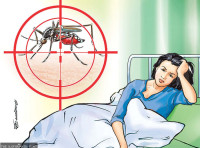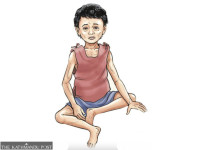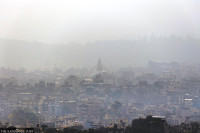Health
High fever kills four women in Salyan local unit, scrub typhus suspected
Over 600 residents of Darma Rural Municipality may be infected with the disease, says a local health official.
Biplab Maharjan
A scrub typhus outbreak has spread across Darma Rural Municipality in Salyan district, prompting local authorities to launch health camps for testing and awareness. The move follows the deaths of four women over the past two weeks, all suffering from high fever with symptoms resembling scrub typhus.
According to health officials, the victims—aged between 35 and 55—died during treatment at the Kohalpur-based Nepalgunj Teaching Hospital. As fever cases surged in the rural municipality, the local government, in coordination with the Salyan Health Service Office and local Gen Z Group, organised mobile health camps in Wards 3 and 5 on Sunday and Monday.
“Out of 67 people tested in ward 3, 23 were confirmed positive for scrub typhus, while 28 out of 61 tested in ward 5 were also infected with the disease,” said Yagya Bahadur Basnet, the health unit chief at Darma Rural Municipality. “One of the patients has been referred to the district hospital for advanced care.”
Basnet estimates that more than 600 residents across the rural municipality are currently suffering from fever. “We have started preparing to expand health tests to all wards from Tuesday,” said Nim Bahadur KC, chairman of Darma Rural Municipality. “Testing will be carried out regularly from health posts in Darmakot, Dhakadam and Bhalchaur,” he informed.
The local people are in abject terror after many fever-patients have been detected with scrub typhus. “Many of us are terrified after four people died because they took medicines from the pharmacy for fever, delaying proper treatment, and several others later tested positive for scrub typhus,” said Lalita Khatri, a resident of Ward 2 of Darma Rural Municipality.
She said the local government must pay greater attention to public health and ensure timely medical services to prevent avoidable deaths. “No one here had heard about a disease called scrub typhus earlier,” she said. “People thought it was just ordinary fever and bought medicines from local medical shops—but that negligence has now turned into an outbreak.”
KC urged residents with fever to visit nearby health institutions immediately. “Since the infection is spreading rapidly, we have mobilised teams to raise awareness in the affected settlements and launched school-based campaigns to protect children,” he said.
Scrub typhus, a bacterial disease transmitted through the bite of infected mites commonly found on rodents, causes high fever, headache and body pain. Public health experts warn that poor hygiene and exposure to bushy or grassy areas increase the risk of infection. “We have advised locals to wear protective clothing while working in fields and maintain household cleanliness,” Basnet said.
Dr Arjun Budhamagar, chief of the Salyan Health Service Office, said the provincial government’s supply of testing kits has run out. “We are currently providing only technical assistance to the rural municipality’s health camps,” he said. “Due to a lack of budget, we have recommended that local governments procure kits from their own resources, while we have also requested additional supplies from the provincial government.”
Scrub typhus, or bush typhus, is a potentially fatal infectious disease caused by the parasite Orientia tsutsugamushi, a mite-borne bacterium. It spreads to humans when bitten by infected chiggers (larval mites) found on mice. Scrub typhus is the second leading vector-borne disease in Nepal after dengue, which infects thousands every year and causes several deaths.
In the fiscal year of 2024-25, at least 16,597 people across the country were infected with scrub typhus. Of the total cases of infection, Lumbini province recorded 4,322 cases, the highest number in the country, followed by Sudurpaschim province (3,746 cases), Karnali (2,539), Koshi (2,119), Bagmati (1,838), Gandaki (1,725) and Madhesh province (308). Some infected people died, but the actual number was not known, as most health facilities lack a proper system to determine causes of death.




 13.12°C Kathmandu
13.12°C Kathmandu














